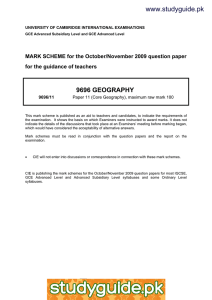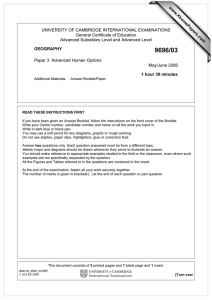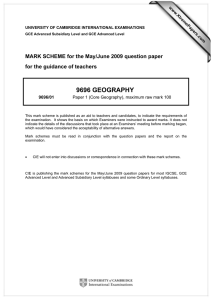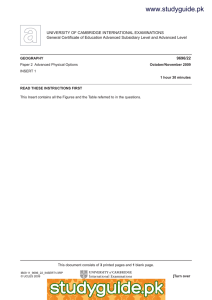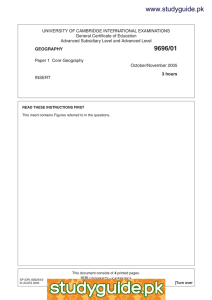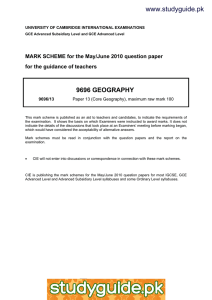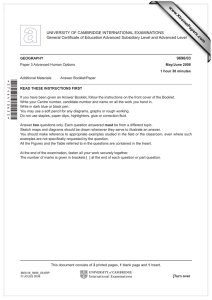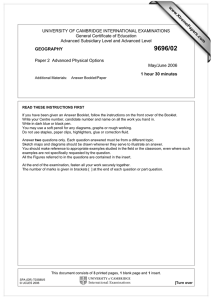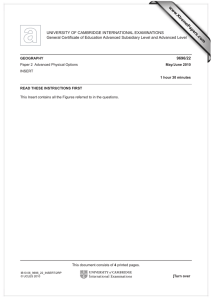9696 GEOGRAPHY MARK SCHEME for the May/June 2010 question paper
advertisement
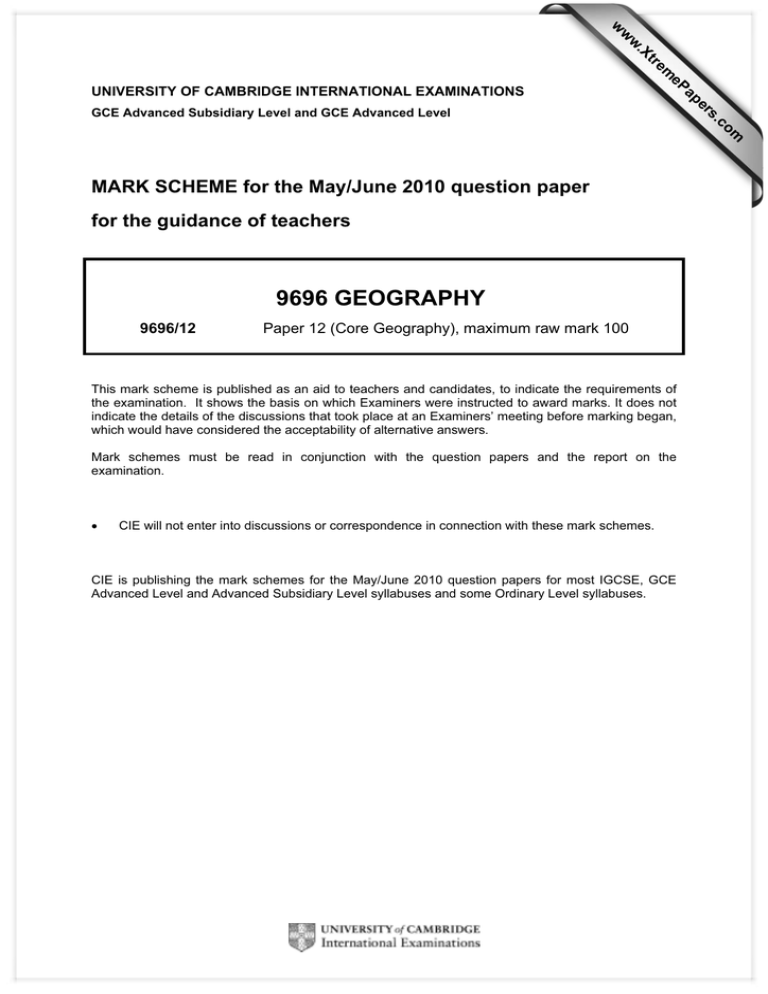
w w ap eP m e tr .X w UNIVERSITY OF CAMBRIDGE INTERNATIONAL EXAMINATIONS for the guidance of teachers 9696 GEOGRAPHY 9696/12 Paper 12 (Core Geography), maximum raw mark 100 This mark scheme is published as an aid to teachers and candidates, to indicate the requirements of the examination. It shows the basis on which Examiners were instructed to award marks. It does not indicate the details of the discussions that took place at an Examiners’ meeting before marking began, which would have considered the acceptability of alternative answers. Mark schemes must be read in conjunction with the question papers and the report on the examination. • CIE will not enter into discussions or correspondence in connection with these mark schemes. CIE is publishing the mark schemes for the May/June 2010 question papers for most IGCSE, GCE Advanced Level and Advanced Subsidiary Level syllabuses and some Ordinary Level syllabuses. om .c MARK SCHEME for the May/June 2010 question paper s er GCE Advanced Subsidiary Level and GCE Advanced Level Page 2 Mark Scheme: Teachers’ version GCE AS/A LEVEL – May/June 2010 Syllabus 9696 Paper 12 Section A Hydrology and fluvial geomorphology 1 Fig. 1 shows the flows and stores of water in a drainage basin. (a) (i) Name the water movement shown as A. [1] Throughflow (ii) Name the water movement shown as B. [1] Baseflow (b) Give the differences between the processes of infiltration and percolation. [2] Infiltration is the entry of water into the surface of the soil whereas Percolation is the downward movement of infiltrated water through the pores and interstices of soil. (c) Using Fig. 1, explain how precipitation may reach the river channel. [6] Precipitation can be intercepted by vegetation with some loss (interception storage) and proceed via throughfall stem flow or leaf drip to surface storage (puddles, lakes, etc). In circumstances of impermeability or high rainfall intensity some water will flow overland to the channel. Infiltration allows water to enter the soil where water can be held within the pores of the soil or proceed downwards by gravity through percolation to form ground water. Water flows from both stores laterally under gravity and hydrostatic pressure to the channel via through flow (pipes) and groundwater flow. [Total: 10] © UCLES 2010 Page 3 Mark Scheme: Teachers’ version GCE AS/A LEVEL – May/June 2010 Syllabus 9696 Paper 12 Atmosphere and weather 2 Figs 2A and 2B show two ways in which air is uplifted. (a) (i) Name the type of uplift shown in Fig. 2A. [1] Orographic uplift (ii) Name the type of uplift shown in Fig. 2B. [1] Convective uplift (b) Describe how air is uplifted in Fig. 2B. [3] The earth’s surface is heated by solar radiation (short wave) and converted to long wave radiation which warms the air in contact with it. The air pocket becomes less dense (expansion of molecules) and warmer than surrounding air and thus rises until such time as it is at the same temperature as surrounding air. (c) Explain how clouds and rain may be produced by the uplift of air in both Fig. 2A and Fig. 2B. [5] When air is forced to rise orographically it will cool adiabatically until dew point temperature is reached, when condensation will occur around hygroscopic nuclei forming clouds and through coalescence, etc rainfall. Convective heating produces the same adiabatic cooling and the development of cloud and ppt after condensation level. The main difference being the rain shadow effect of orographic uplift and the propensity for the development of cumulonimbus after convection. [Total: 10] © UCLES 2010 Page 4 Mark Scheme: Teachers’ version GCE AS/A LEVEL – May/June 2010 Syllabus 9696 Paper 12 Rocks and weathering 3 Figs 3A and 3B show two types of the physical weathering of rocks. (a) (i) Name the weathering process shown in Fig. 3A. [1] Freeze thaw (ii) Name the weathering process shown in Fig. 3B. [1] Exfoliation (thermal fracture). (b) Describe the differences in the climatic conditions under which the processes in 3A and 3B are most effective. [4] Freeze thaw is most effective where temperatures frequently cross the freezing threshold (i.e. diurnally rather than seasonally) and where there is an availability of water. Hence temperatures should not generally be below –5°C to –15°C. Exfoliation requires a wide diurnal range of temperatures ideally from greater than 25°C down to 0°C. Hence the clear skies and high temperature range of hot deserts are best. (c) Explain the effects these weathering processes have upon rocks. [4] Freeze thaw occurs in fissured rock and a long series of cycles of water freezing and thawing can lead to the detachment of joint bound blocks of rock giving rise to blockfields or felsenmeer. Where freezing occurs in rock pores, granular disintegration can take place. Exfoliation is most effective in dark crystalline rocks and leads to surface expansion and contraction weakening surface sheets of rock which will eventually detach themselves to form platy fragments. [Total: 10] © UCLES 2010 Page 5 Mark Scheme: Teachers’ version GCE AS/A LEVEL – May/June 2010 Syllabus 9696 Paper 12 Population 4 Fig. 4 shows the age/sex structure of deaths in an MEDC. [2] (a) Identify the 5-year age group which recorded: (i) the lowest percentage of total deaths; [1] 10–14 (ii) the highest percentage of total deaths. [1] 80–84 (b) With the help of information from Fig. 4, describe the differences between the ages at which males and females died. [4] Clear pattern that the male population dies at younger ages than the female population, and evidence can be developed for full marks, with reference to different age groups. For example, the first age group in which more females die than males is 80–84. In the 95+ age group, approx. 1% males, but almost 4% females die. The structure is unbalanced to the left (male side) notably, through childhood, adolescence and adulthood, for example infant mortality affects twice the percentage of male babies than female babies. (c) Give two reasons which help to explain why MEDCs record only a small percentage of total deaths under 50 years of age. [4] Candidates may develop any two different reasons, possible reasons include: - healthcare systems: high quality, good access, some free/low cost food provision: quantity and quality, food shortage unknown housing quality: safe, clean, sanitary clean pure water supply educated populations aware how to take care of themselves health and safety reduces accidents in home, at work, etc. some causes of death cannot be overcome even by the best healthcare systems, e.g. terminal illness, AIDS Please note that high life expectancy is not, in itself, explanatory but may form part of an aware response. Weaker candidates may write quite generally of “the best of everything”. Suggest credit the two reasons usually 2, 2, but allow a very well developed point 3. [Total: 10] © UCLES 2010 Page 6 Mark Scheme: Teachers’ version GCE AS/A LEVEL – May/June 2010 Syllabus 9696 Paper 12 Migration 5 Fig. 5A shows net migration in North America and South America in 2002. Fig. 5B names the countries shown. Net migration is the balance between the number of in-migrants and the number of out-migrants. (a) Name the country in Fig. 5A for which net in-migration of 10 000 to 49 999 people was recorded in 2002. [1] Argentina (b) Describe the pattern of net migration shown in Fig. 5A, supporting your response with information from both figures. [4] The pattern is complex or mixed, but a broad north/middle/south pattern can be observed of gains/losses/gains. Canada and the USA had the greatest gains (50 000+) Mexico, bordering the USA to the south, had the greatest losses (-50 000+) Central and most of South America experienced net losses in all categories. The only two countries in South America which had net in-migration were in the south of the region (Chile and Argentina), with Argentina having the greatest gains, as in (a). A full response refers to both North America and South America and provides data support for the description. (c) Explain the factors that may influence the chosen destination of a young adult migrating from Brazil, an LEDC. [5] Migration decision-making is complex and individual; here a combination of pull factors and constraints may be taken, including: - betterment distance information contacts opportunity barriers character culture e.g. maximising economic opportunity and return/remittances e.g. in relation to cost, visits home e.g. in the media, from relatives or friends, hearsay e.g. work, family members, friends, links e.g. job openings, transport available e.g. political, economic, personal, physical e.g. risk-taker, optimism/pessimism, fears, judgements e.g. proximity or distance, a Brazilian enclave, language Reward factor-awareness and an appreciation of the realities of migration decision-making for an individual. The explanation may be set in the context of Fig. 5B. [Total: 10] © UCLES 2010 Page 7 Mark Scheme: Teachers’ version GCE AS/A LEVEL – May/June 2010 Syllabus 9696 Paper 12 Settlement dynamics 6 Fig. 6 shows the growth in world population, 1970–2000, and its predicted growth to 2030. (a) Use Fig. 6 to identify in which category of settlement: (i) most of the world’s population lived in 1970; [1] rural (ii) it is predicted that most of the world’s population will live in 2030. [1] urban areas in LEDCs (do not accept “urban”) (b) Describe the growth in the urban population of MEDCs, 1970–2030, supporting your response with information from Fig. 6. [3] Small, smooth, progressive increase over time, from less than 1 billion in 1970, to just over 1 billion (predicted) in 2030. Some candidates may have difficulty in separating this sector from Fig. 6 and may give incorrect data from the y axis as a consequence. (c) How may the growth of population in urban areas in LEDCs, shown in Fig. 6, be explained? [5] By a combination of: • • • natural increase (BR>DR) linked to Stages 2 and 3 of the demographic transition model rural-urban migration and the stage of the urbanisation cycle/process of urbanisation. Urbanisation is the progressive concentration of population into urban areas (towns and cities) over time. For an explanation based on one of the above elements, max. 3. [Total: 10] © UCLES 2010 Page 8 Mark Scheme: Teachers’ version GCE AS/A LEVEL – May/June 2010 Syllabus 9696 Paper 12 Section B: The Physical Core Hydrology and fluvial geomorphology 7 (a) (i) Define the terms helicoidal flow and laminar flow. [4] Helicoidal flow is a type of corkscrew flow which moves across a meander. Laminar flow is a smooth slow velocity movement of water over a smooth surface. (ii) Describe turbulent flow and the conditions under which it occurs. [3] Turbulent flow is a rapid eddying of water in the channel in circumstances of channel roughness, increased velocity and a reduction in depth. (b) Using diagrams, explain the formation of: [8] (i) a river cliff; (ii) an oxbow lake. River cliffs are found on the outside of meander bends where the river bank is eroded by the swing of the current through helicoidal flow. An oxbow lake is a crescent shaped lake that was once part of a river meander that has been cut off and abandoned by lateral erosion of the banks at the meander neck. (c) Explain how urban growth could affect flows within a river channel. [10] Urbanisation can increase flows into a river channel by way of its impermeable surfaces and storm drains often replacing baseflow. This will tend to increase both quickflow discharge and velocity. This effect is most prominent in the immediate vicinity of the river but its effects can be felt to a lesser extent by more distant urbanisation within the catchment area. In urban areas channels are often canalised producing more rapid flows and attempts are made to restrict flooding by embankments etc and channel straightening. Emphasis should be on flows and not general material on landuse changes throughout catchment areas. Candidates will probably: L3 Concentration on channel flows and the impact of urbanisation. Thus discharge and velocity will be seen as responding to both input and changes to channel shape. [8–10] L2 A more generalised account of the effects of land use change to urban within a catchment i.e. a reduction in lag time, etc. Some mention of flows but not the main focus of the account. [5–7] L1 Basic ideas on impermeable surfaces and overland flow which will be seen as leading to flooding. Little on channels or flow. [0–4] [Total: 25] © UCLES 2010 Page 9 Mark Scheme: Teachers’ version GCE AS/A LEVEL – May/June 2010 Syllabus 9696 Paper 12 Atmosphere and weather 8 (a) (i) Define the terms solar radiation and earth (terrestrial) radiation. [4] Solar radiation is incoming short wave radiation from the sun. Terrestrial radiation is outgoing long wave radiation from the earth’s surface which has been heated by solar radiation. (ii) How does radiation cooling occur at the earth’s surface? [3] Radiation cooling at the earth’s surface occurs due to the loss of long wave radiant heat during the night. The surface loses heat faster than the air in contact with it thus cooling the lower layers of the atmosphere. (b) Using a diagram or diagrams, explain why the earth’s surface receives less solar radiation in polar areas than in equatorial areas. [8] Simple diagram or diagrams showing the greater amount of atmosphere that solar radiation has to pass through at the polar latitudes. Seasonal tilt also means that polar areas receive little or no solar radiation during winters. Distance from the sun is not acceptable as an explanation. The overhead sun is thus concentrated on equatorial areas reducing scattering and other losses. Some may well introduce albedo etc from snow and ice surfaces. (c) Explain how human activities have contributed to global warming. [10] Human activities have largely been responsible for the increase in greenhouse gases which have enhanced the greenhouse effect. This should be explained and the sources of increased carbon dioxide and methane explained in terms of increased use of fossil fuels, increased agricultural activity (pastoral and rice growing), as well as the destruction of carbon sinks (e.g. tropical rainforest). Emphasis should be on the greenhouse effect rather than the nature of the human activities. Candidates will probably: L3 Good understanding of the greenhouse effect and its effect on global warming. Human activities directly linked to this. [8–10] L2 Some grasp of greenhouse gases and their contribution to global warming, but more emphasis on the human activities (e.g. car ownership, power supplies destruction of TRF). [5–7] L1 Doomsday account of the effects of global warming with little exploration of the causes or nature of the greenhouse effect. [0–4] [Total: 25] © UCLES 2010 Page 10 Mark Scheme: Teachers’ version GCE AS/A LEVEL – May/June 2010 Syllabus 9696 Paper 12 Rocks and weathering 9 (a) (i) Define the terms continental plate and oceanic plate. [4] Continental plates are composed of sial and carry the continents. It is thus thicker (33 km upwards). Oceanic plates underlie the oceans and are composed of younger sediments and basaltic lavas. They are thinner — 10–16 km thick. (ii) Briefly describe how sea floor spreading occurs. [3] At divergent or constructive plate margins the plates move apart under the influence of convection currents to allow the introduction of magma and thus the creation of new sea floor. A well annotated diagram would suffice. (b) Using diagrams, describe how landforms are produced at convergent (destructive) plate margins. [8] The emphasis should be on landforms, thus the diagrams and description should be directed at the production of ocean trenches, fold mountains, island arcs and volcanoes. Generic subduction diagrams that have few or no landforms which should receive only modest credit. (c) Explain how mass movements can affect the shape of slopes. [10] Mass movements can be divided into falls, slides and flows. The most dramatic are those that occur quickly over large areas with the addition of water such as landslides and mud flows. The emphasis is on the effect on the shape of slopes, although this may be ignored by many or merely suggested by implication from the diagrams. The general effect of slope instability is to reduce the steepness of the slope and angle of rest although this can have the effect of increasing slope angle when free faces are exposed at the top of sloes in the case of slides or slumps. An exhaustive catalogue of all mass movements is not required. Candidates will probably: L3 Concentration on the effects upon slope shape. Hence such things as the extended slope toe in flows or the impact of rotational slumps. Contrast the steepening of the top of the slope as against the lower angles of the material moved. [8–10] L2 A series of diagrams of types of mass movement with some explanation mainly geared to the nature of the movement rather than the slopes produced. [5–7] L1 A rather random collection of mass movements with little explanation or awareness of slope impact. [0–4] [Total: 25] © UCLES 2010 Page 11 Mark Scheme: Teachers’ version GCE AS/A LEVEL – May/June 2010 Syllabus 9696 Paper 12 Section C: The Human Core Population 10 (a) (i) Give the meaning of the term carrying capacity in connection with population. [3] Carrying capacity means the maximum number of people which the resources of an area of land, or an environment, can support. It is a theoretical number. Suggest credit 1 the three key ideas of a maximum; resources; and support or sustain, in an effective definition. (ii) Describe how two constraints may limit the capability of resources to feed a population. [4] Any two constraints are acceptable; the syllabus lists “war” and “climatic hazards”. Description needs to show how these disrupt or stop food production/distribution. Suggest credit 2 and 2. (b) Explain how, when two countries have the same population density, one may be overpopulated and one underpopulated. [8] Population density is the average number of people per unit area, such as per square kilometre. The key concept here is that these two terms are relative, and express population in relation to resources at a given level of technology. So a resource-rich MEDC with sophisticated technology may be underpopulated, but an LEDC with poor resource endowment (soil, climate, minerals, etc.) and traditional technology may be overpopulated. Relatively brief responses with good technical understanding may readily achieve high marks. (c) Assess the success of one or more attempts by governments to change the population-resource relationship. [10] This may be attempted by increasing population, decreasing population, or increasing resources, e.g. China’s “one child” policy, the Green Revolution. Candidates will probably: L3 Make a response from detailed knowledge and strong conceptual understanding. Provide an effective assessment. [8–10] L2 Make a reasonable attempt, which may contain good points, but which remains partial. Offer a valid, but limited, assessment. [5–7] L1 Offer one or more basic ideas and struggle to deal with the issue. Take a descriptive approach, making little or no assessment. [0–4] [Total: 25] © UCLES 2010 Page 12 Mark Scheme: Teachers’ version GCE AS/A LEVEL – May/June 2010 Syllabus 9696 Paper 12 Migration/Settlement dynamics 11 (a) Give the meaning of the term stepped migration and explain why it occurs within the settlement hierarchy. [7] stepped migration occurs where a migrant reaches their destination in a number of steps or stages), rather than in one movement from source to destination. For example, up the settlement hierarchy from home village, to regional city and on to the capital city, or in a return move down the hierarchy. It occurs for a variety of reasons: social, e.g. reducing risk, trying a new life, issues of culture and language; economic e.g. known job opportunity, saving up for next step; political, e.g. civil unrest, need for a permit. Factors such as life cycle matter, e.g. to a rural area in retirement. Suggest credit the meaning 3 and the explanation 4. (b) With the help of examples, describe and explain the push factors which may influence people to migrate from large urban areas. [8] Push factors are those which operate to prompt or stimulate someone to leave a place. Responses will vary with the large urban areas considered (e.g. MEDC/LEDC; war/peace). Push factors may be actual or perceived positives and negatives, and operate in all four dimensions: - social economic political environmental e.g. relationship breakdown, educational achievement e.g. rent increase, loss of job, a windfall e.g. getting into trouble with authorities, regime change e.g. decline in quality of life, pollution, noise Reward actual, located, examples and an awareness of migration decision-making. (c) Examine the connections between a person’s age and migration. [10] Classically, for voluntary migration, younger adults are more migratory than older adults, children migrate with parents and many movements relate to the life cycle, such as making a career, or retiring. Forced (involuntary) migration affects all and is not linked to age. Candidates will probably: L3 Examine a number of links between age and migration in an account which is good quality, strong conceptually and well-supported. [8–10] L2 Provide a sound response which may be good in parts, but which is limited through lack of detailed knowledge or overall context. [5–7] L1 Lack the knowledge or time to make more than a basic response, perhaps struggling to identify age as a variable. [0–4] [Total: 25] © UCLES 2010 Page 13 Mark Scheme: Teachers’ version GCE AS/A LEVEL – May/June 2010 Syllabus 9696 Paper 12 Settlement dynamics 12 (a) Explain why the majority of people in many cities in LEDCs live in slums, shanty towns or squatter settlements. [7] For a combination of reasons, which include: • people’s inability to afford the high rents of other dwellings (poverty, unemployment, underemployment, survival, etc.) • demand for dwellings exceeds supply (natural increase, in-migration, small-scale house building programmes, refugees) • these areas may offer much as communities, e.g. in terms of support and proximity to workplaces, as “slums of hope” • property markets may operate to exclude those who are poorer, lower status, immigrants, etc. • these areas are part of city identity and urban history, many are long established and so persist Suggest that a full answer consists of three or more developed reasons. (b) Between 2001 and 2003 approximately half a million people were evicted from shanty towns in Jakarta, the capital of Indonesia, an LEDC in Asia. With the help of examples, suggest reasons why city authorities may seek to remove shanty towns and squatter settlements. [8] For a variety of reasons, including, the need for space for other (strategic, or more lucrative) purposes, e.g. road building, as sites for investors prestige or potential embarrassment, e.g. a clean-up before an international event or the visit of dignitaries as part of a programme to relocate residents to better housing as a health hazard, e.g. during an epidemic other Any examples may be used, such as Operation Murambatsvina, Zimbabwe, in 2005, affecting approximately 2.5 million people (UN). (c) Assess the success of attempts to improve the quality of life in one or more shanty towns or squatter settlements you have studied. [10] Candidates will probably: L3 Develop a good assessment of different attempts, with exemplar detail. conceptual understanding of “quality of life”. Show firm [8–10] L2 Make a satisfactory but limited response, which may be rather general. The assessment may be broad, partial or lack support. [5–7] L1 Make one or more basic points in a response which is a description rather than an assessment. Write generally about attempts or use an example in name only. Offer notes or fragments. [0–4] [Total: 25] © UCLES 2010
